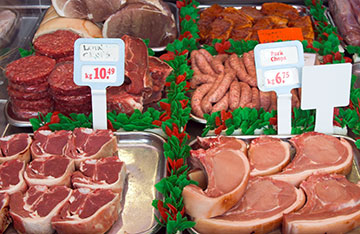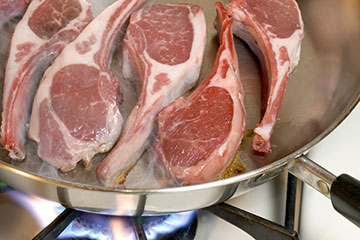Selecting Lower-Fat Meats for a Healthy Diet
The general trend in eating habits is moving more towards health-consciousness these days. People are trying to moderate their consumption of salt, fat, and carbohydrates, among other things. These goals are easy to achieve with vegetarian diets, but what if we don't want to forego the rich and satisfying flavors of meats? If selected with care, meat can still remain a part of our healthy and balanced diets. This means you can still enjoy eating meat, while you maintain a healthy diet to lose weight.
 Because so many consumers are concerned about the fat content in beef, ranchers have responded by raising leaner breeds of cattle. These animals are fed more grass and less corn; also they're sent to the market at a younger age, before they've grown fat. Butchers also generally trim more fat off of their cuts nowadays.
Because so many consumers are concerned about the fat content in beef, ranchers have responded by raising leaner breeds of cattle. These animals are fed more grass and less corn; also they're sent to the market at a younger age, before they've grown fat. Butchers also generally trim more fat off of their cuts nowadays.
The rest is up to us. There is a wide variety of meats to choose from that vary in fattiness. Ground beef moves up to ground chuck (about 80% lean), ground round (85%) and finally sirloin (the leanest at 90%). A batch of ground beef can also be judged by its color. Because the white streaks in it are fat, the darker and redder meat will be leaner. Cuts of beef are graded as either select (the leanest, but least flavorful), choice (the grade most commonly available in supermarkets), and prime (which contains the most fat). Choice beef can make a delicious steak without the fat and higher expense of prime. Veal is often leaner than other kinds of beef because it comes from young animals. Top-quality veal can be hard to find, though, even at butcher shops.
 Lamb cuts can also be distinguished as "prime" or "choice", but in this case the grade refers to the quality of the meat and not its fat content. Ground lamb from the supermarket is generally fatty, so a better option would be to buy lean cuts from a butcher and have them ground. Butchers can also be the best authorities on pork. Some hams, for example, can be much lower in fat - and tastier - than others. As a general rule, we should avoid bacon and sausage and limit our consumption of ham if we're concerned about sodium content. A good low-fat alternative to both beef and pork is venison, which nowadays comes from farm-raised animals. Whatever kind of meat we opt for, we should buy it only from stores that offer fresh, good quality, and well-trimmed cuts.
Lamb cuts can also be distinguished as "prime" or "choice", but in this case the grade refers to the quality of the meat and not its fat content. Ground lamb from the supermarket is generally fatty, so a better option would be to buy lean cuts from a butcher and have them ground. Butchers can also be the best authorities on pork. Some hams, for example, can be much lower in fat - and tastier - than others. As a general rule, we should avoid bacon and sausage and limit our consumption of ham if we're concerned about sodium content. A good low-fat alternative to both beef and pork is venison, which nowadays comes from farm-raised animals. Whatever kind of meat we opt for, we should buy it only from stores that offer fresh, good quality, and well-trimmed cuts.
It's helpful to research further and discover where the meat we buy is coming from. In many grocery stores, brands are available from local farms that raise their animals free-range without administering growth hormones. These practices are more ethical and produce meat that's healthier to eat. Also, meat from local farms is usually fresher because it's shipped shorter distances. Generally speaking, farms that raise their livestock naturally are proud of the fact and will say so on their packages.
Just because weight loss is your goal, doesn't mean you have to give up meat. Use the tips on this page to make wise choices in cuts and remember to eat proper portion sizes, and you can enjoy delicious meats without consuming vast amounts of fat. Eating a meal of lean meat along with fresh vegetables and other nutritious sides can certainly be part of a tasty and healthy diet.
Diet Plan Coupons
- Nutrisytem
- Medifast
- Diet to Go
- Weight Watchers
- Jillian Michaels
- South Beach Diet
- Cookie Diet
- Duke Diet
- Bob Greene BestLife
- eDiets
- Sonoma Diet
- Denise Austin
- Biggest Loser Club
